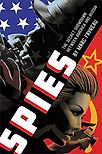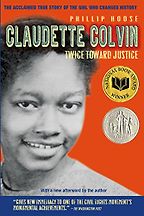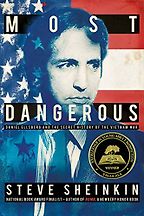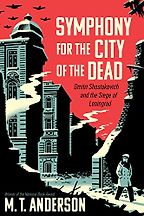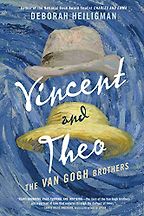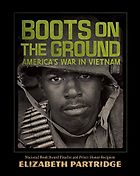Fiction for young adults is flourishing. Can the same be said of Young Adult (YA) nonfiction?
Compared to YA fiction, which is probably the fastest growing and the most dynamic part of book publishing, it’s incipient. But YA nonfiction looks immensely different than it did a few years ago. A decade or so ago, YA nonfiction was a sleepy category made up of not much more than biographies and reference books. It’s still hard to find a separate section for it in a bookstore; although that’s changing very rapidly.
I’d say it’s about to flourish. A number of really sophisticated writers are migrating into this category and developing original writing for a YA audience, which is challenging and interesting. There’s a lot of talent coming this way. We’ll see a big change in the coming years.
Your day job is editing adults who write for adults. So, I figure you’re the perfect person to ask about how YA is changing the way history is recorded and relayed. But I’d like to begin with an industry question: Is publishing bifurcated between books for children and those for adults?
It is bifurcated. Although there are overlaps when it comes to marketing, the imprints are separate. And the way YA is marketed is quite different. There’s a really significant effort to reach out to librarians as a bridge to this readership because it’s still the case that parents and young people are using their school libraries and their local libraries to find out about books. They are very different worlds, but increasingly adult readers are crossing over because of the offerings from YA imprints.
One way in which adults are paying attention to books for young adults is with awards and best-of lists. For instance, the New York Times recognizes the best titles for young adults each year and in 2019, Spies, your latest, is among them. Before we talk about the books that you’ve named, tell me about Spies please.
Spies is about the hidden history of the Cold War, the espionage wars between the US and the Soviet Union. It’s about real spy stories that involve a lot of incredible characters, technology and escapades. I wrote it as something that anybody could read, as a backstory to the present.
The history of the struggle between Russian and US intelligence is of renewed relevance.
Until the last few years, Americans seemed to have had collective amnesia about Russian security services’ attempts to subvert the United States. That subversion is not only something that may or may not have happened in the last three years. It’s important to understand how deep it goes and how threatening it is.
On to the five books you’ve chosen. Let’s begin with Philip Hoose’s Newberry-winning Claudette Colvin. Tell us about it.
It’s a slim book that contains an immense amount of information about one of the most well-known periods in contemporary American history—the dawn of the Civil Rights movement. It presents that history in a unique way.
Prior to this book, even among civil rights specialists, the name Claudette Colvin was not well known. This book corrected that oversight. Philip Hoose found Colvin living in the Bronx and reconstructed her story. As a fifteen-year-old, she was arrested for refusing to give up her seat on a bus in Alabama. This was eight or nine months before Rosa Parks took her stand in Montgomery. At that time, it was felt that she was not the right figurehead for the civil rights struggle—perhaps, in part, because she got pregnant as a girl. So, she was pushed aside, and Rose Parks took a stand in her stead.
“YA nonfiction looks immensely different than it did a few years ago”
You’re looking for the special sauce in YA nonfiction. In each of the five books I named, it’s different. In this one, there’s something powerful about first-person testimony. At the New Press where I edit adult nonfiction as a day job, we publish the late Studs Terkel, who had this notion that you can learn new things about history by talking with ordinary people. This book is evidence of Terkel’s theory. It was published without much fanfare but went on to win the National Book Award.
Hoose tells Claudette’s story from her perspective, through original oral history. He takes you inside her head. It demystifies the civil rights movement. Her story of personal courage and struggle, as a young marginalized African American woman in the South, is stunning.
You mentioned that although it’s aimed at young adults, by elevating a transformative historical figure, Hoose performed a function normally performed by academic historians. Is Claudette Colvin unique in that respect, or do YA authors often work with archives and oral history?
More and more young adult nonfiction writers are doing the same type of scholarly work done by the writers of adult nonfiction. These aren’t monographs, but they are often as rigorously researched as what is published by a university press or one of the big adult trade publishers. The field is attracting talented writers who ground themselves in the secondary literature and do other reporting, research and interviews to reconstruct nonfiction stories in new and more dynamic ways.
The process of writing is partly one of inclusion and exclusion, and of deciding how to develop a narrative in a dynamic way. Writing for YA readers involves all of the same challenges of writing for any audience—but I believe that it also accentuates these challenges. With YA, you can’t take anything about your audience for granted, which imposes and added layer of responsibility. And you have to hold their attention.
Holding the attention of young adults is something that Steve Sheinkin is very good at. Let’s talk about a book of his that you’ve named, Most Dangerous.
Steve Sheinkin is one of the most prolific and talented writers at work today. More than anyone, he elevated YA nonfiction by writing extraordinarily original history for young people. He has a knack for writing fast-paced books that take a cinematic approach to historical narrative. He talks about how, when he worked for a textbook publisher, he developed the determination to do everything he could to make his books ‘not boring.’ That impulse inspires what he does, and it inspires me.
Sign up here for our newsletter featuring the best children’s
and young adult books, as recommended by authors, teachers, librarians and,
of course, kids.
The story of the high-stakes effort to steal the Pentagon Papers—which assessed the success of America’s involvement in the ongoing war in Vietnam—and disseminate them is at the core of Most Wanted. When I first saw the title, I couldn’t imagine why he chose this as a subject for young adults. I mean, I find Daniel Ellsberg an inspiring, interesting character, but it seemed like an odd subject for an uninitiated reader. But Ellsberg is the special sauce of this particular book. Sheinkin ingeniously uses Ellsberg’s quirks and his life story to give readers a unique look at America’s involvement in Vietnam. He does it as well as any adult writer could have handled this material.
Would you recommend this to an adult reader?
I would and I have. It’s an accessible way to learn about the Vietnam War, one that is completely appropriate for adults, as well as young adult readers. It does not shy away from the stark facts of war. I chose it because it’s an example of how YA authors are insisting that almost any subject matter is appropriate for someone capable of reading, even an 11 or 12-year-old.
On to another one of your choices about an unlikely topic for a YA nonfiction reader. Tell me about MT Anderson, Symphony for the City of the Dead.
MT Anderson came to YA with some serious writing chops. He’s primarily known as a YA novelist. The Astonishing Life of Octavian Nothing, Traitor to the Nation, an immensely clever story about an enslaved boy living in Boston during the Revolution, is probably his most famous book to date. I love it.
Symphony for the City of the Dead is, in brief, the story of the Russian composer Dimitri Shostakovich and his Seventh Symphony, which he composed during the 444-day Siege of Leningrad by Hitler’s armies during World War Two. Estimates are that a million people died during the siege. Anderson’s book is about that piece of music and its significance, but it’s also about Leningrad and Russia. Overlaid on all of that, it’s also almost an espionage caper—with the microfilm holding the Seventh Symphony score spirited out of Russia and following an unbelievably byzantine route that brought it to the United States. The plan was to perform the symphony as a way of drumming up support for Russia during World War Two.
This is subject matter that is very, very challenging and important. It must’ve taken years of research. It’s an incredibly multilayered history and narrative, both fast-paced and readable. I recommended it to many of my adult friends who read serious nonfiction, because it delivers for any reader.
You mentioned that Sheinkin takes a cinematic approach to his writing. That seems to apply to Symphony for the City of the Dead and Spies as well.
Giving space and attention to the detail of setting allows reader to see a story and envision the environment of revolutionary Russia—and in the case of Spies, for example, Moscow in 1973. Endless paragraphs of thick description won’t work. Cinematic approaches give readers just enough detail to imagine what a historical setting was like and then move swiftly from scene-to-scene. Sheinkin and Anderson both do that really well.
Next, a story about brothers, but hardly a buddy book: Deborah Heiligman’s Vincent and Theo: The Van Gogh Brothers. Please tell me about it.
It’s so different than the YA nonfiction we’ve just discussed. Heiligman’s book is a multi-layered work of cultural history. It is a tightly wound story of two brothers, one of whom goes on to become one of the most famous impressionist painters and the other a seller of paintings. Both Van Gogh brothers played a central role in the history of late 19th-century art and ended up dying tragically, within months of one another.
Five Books interviews are expensive to produce. If you're enjoying this interview, please support us by donating a small amount.
It gives the reader a feel for Western Europe in the 1870s and 1880s, for the countryside and vibrant art scene that inspired the brothers. It builds into a full biography of Van Gogh and his cohort. History is not at the center of the book; it’s the wings for the story.
It’s different from the other titles on this list, but they are all examples of the extraordinary level of talent that writers are bringing to this category.
What makes it different?
It’s a spare narrative, almost a literary work, written in a novelistic voice that at times is internal to the minds of the two central characters. Readers who are not inclined towards history and nonfiction could easily get pulled into the story. You could approach it with no prior knowledge of art history or even with no prior interest in art. It’s the type of book you can hand to almost any kid and they would be drawn to it.
That brings us to a title that garnered a great deal of mainstream media attention when it was published in 2018. Tell us about Elizabeth Partridge’s Boots on the Ground.
It was longlisted for the National Book Award and was also a finalist for the YALSA [Young Adult Library Services Association] Excellence in Nonfiction Award, two of the most important distinctions for this category. It made quite an impression. Boots On The Ground is a chronological examination of the Vietnam War as it unfolded, and also framed by the story of how the Vietnam Memorial in Washington came about. It is a meditation on how a nation remembers war and why memory is so fraught.
“It is a meditation on how a nation remembers war and why memory is so fraught”
The special sauce here is a convention that many adult writers use. Partridge shows the war, as it happened, through the eyes of eight characters. These characters include soldiers on the ground, a nurse, a refugee, and political leaders. The core characters in the book are all still alive today. Partridge did a lot of original reporting to give her readers these varied perspectives. In my experience, among high school students, there’s a prevalent attitude of ‘why do we need to worry so much about the past?’ The fact that the characters in Partridge’s account are still walking around among us—and still grappling with the legacies of the Vietnam War—makes it easier for this history to penetrate for young people.
Physically, this is a beautiful book. As someone in publishing, I can see how much work went into this. It’s a wide format. A lot of original archival photographs, pictures that were unfamiliar to me, are beautifully reprinted. The graphical elements of the book are gorgeous. It makes you want to pick it up and spend time with what’s inside.
You mentioned Partridge uses a lot of archival imagery, as you do extensively in Crash. How do you make archives come alive for young adults?
Crash is about the Great Depression. A big part of the New Deal was devoted to cultural programs, which collected an enormous quantity of visual material, from photographs to posters to other graphic artwork. These in a sense enabled the New Deal programs to record history as it happened, and to capture the experience of daily life in America during the Great Depression. In Crash, the photographs aren’t merely illustrating what I’m saying in the text; I use them to convey information that that stands on its own and goes beyond what I can describe in narrative terms. I think young adults have the experience and sophistication to “read” imagery in this way—to me, the challenge is in curating the material effectively for them, as you would for any audience.
Five Books aims to keep its book recommendations and interviews up to date. If you are the interviewee and would like to update your choice of books (or even just what you say about them) please email us at [email protected]

